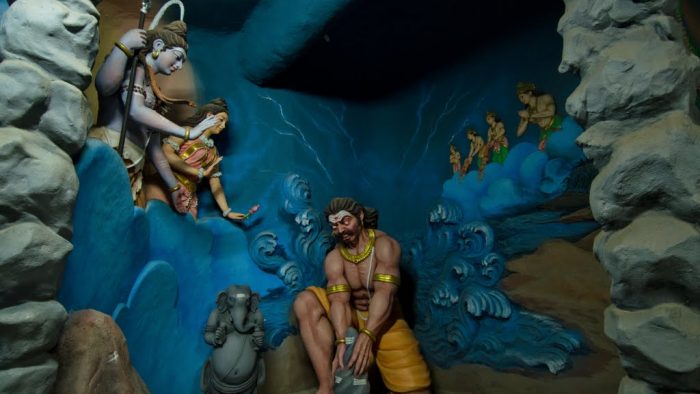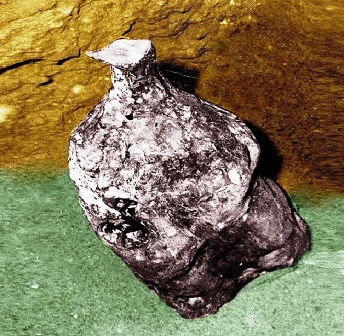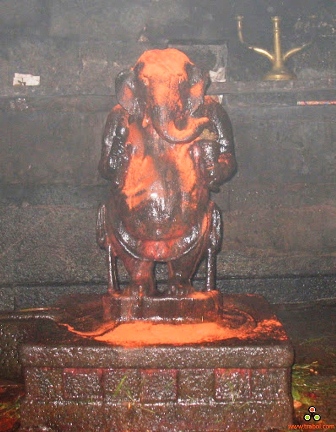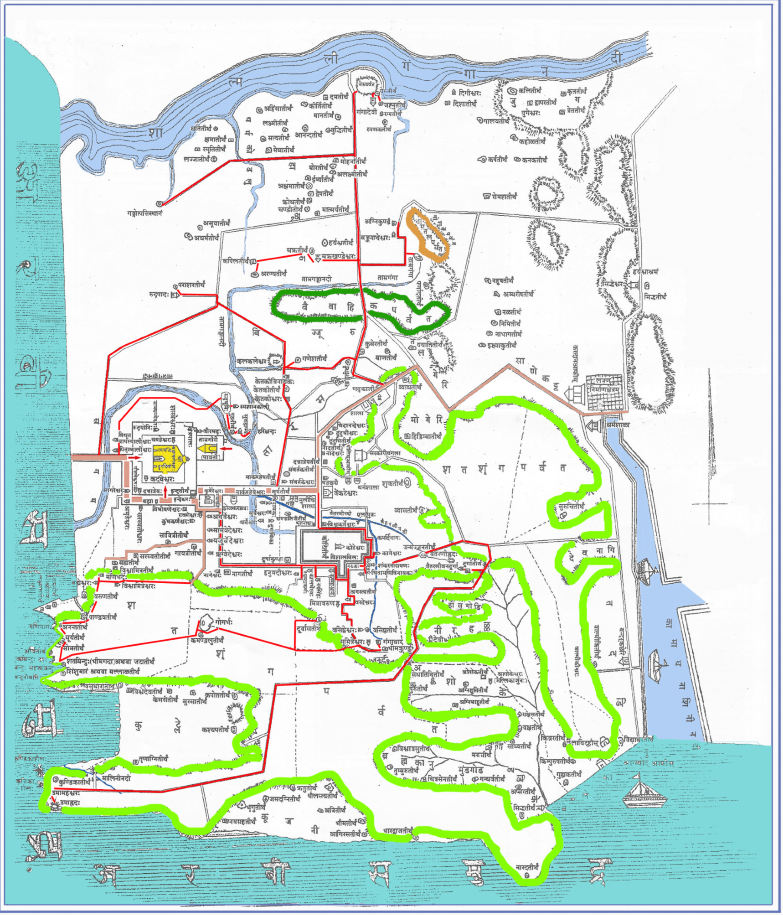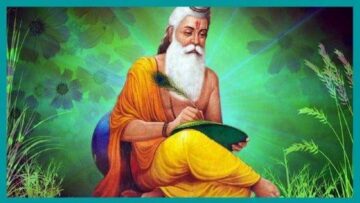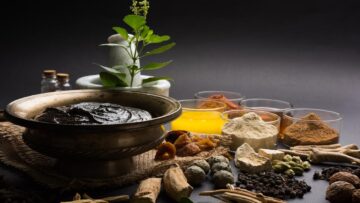Gokarṇa is situated in Uttara Kannada district of Karnataka. Gokarṇa is considered as Dakṣīṇa Kāśī or even superior to Kāśī. Gokarṇa Mahabaleśvara i.e. Lord Śiva is the main deity of this sacred tīrtha. There is a geographical peculiarity in forming the name Gokarṇa of this place. Gaṅgāvalī and Aghanāśinī are two rivers which form the earth into shape of the ear. Here earth which is referred as go in Sanskrit has taken the shape of ear (karṇa). On one side, it is pervaded by Arabian ocean. Confluence of rivers and sea is a geographical significance that has been responsible for numerous sacred narratives and extraordinary significance of this place.
It is believed that Lord Śiva manifested on earth through the ear of earth, therefore it is considered as the land of Śiva and important pilgrimage centre of India. It is said that temple of Lord Mahabaleśvara has the ātmaliṅga of Śiva i.e. Śiva resides in his own form. Besides this, Gokarṇa has numerous sacred places out of which Dvibhuja Gaṇeśa, Tāmragauri, Ādigokarṇa, Koṭitīrtha are popularly known. It is said that गोकर्णं च महाकाशी विश्वनाथो महाबल: । कोटितीर्थं च गंगाया: सामुद्रमधिकं फलम् ॥ i.e., Gokarṇa is superior to Kāśī being revered as Mahākāśī, Lord Viśvanātha here is known as Mahābala (very powerful), Koṭitīrtha is superior to Gaṅgā due to its association with ocean. Gokarṇa is mentioned as a pious tīrtha in epics and purāṇas. Prominent oral narrative about the place stating its glory is that of Rāvaṇa and Gaṇapati but this narrative is not found in mahāpurāṇas which are popular for glorifying tīrthas.
Story appears in Ānanda Rāmāyaṇa (Sārakāṇḍa, 13th sarga) with slight variations. Gokarṇa is mentioned as sacred place in Bhāgavatamāhātmya which is responsible for the liberation of Dhundhukāri who wondered in the form of ghost. Mentions of this place are found in epics as well as in various purāṇas. Gurucaritra (7th adhyāya) a text affiliated to Datta sampradāya mentions this place with great reverence. There is no māhātmya narrative dedicated to Gokarṇa in mahāpurāṇas. It remains a question that why Gokarṇa is mentioned with great reverence. This paper aims to explore Gokarṇa Purāṇa which is unknown to the scholarly world.
Gokarṇa Purāṇa:
Gokarṇa Purāṇa or Gokarṇakhaṇḍa is an unexplored text in Sanskrit dedicated to the glory of Gokarṇa Mahābaleśvara. This is edited by Shri Gajanan Hire and published by Sadyojata Shankarashrama Swamiji Chitrapur in 2004. This text is a great compendium of narratives dedicated to Gokarṇa; and therefore forms an important link in reconstructing cultural history of this place. Gokarṇa Purāṇa helps to explore various sacred places and pilgrimage circuits which are lost into oblivion.
Structure:
This purāṇa is in Sanskrit language and is divided into 118 adhyāyas. Gokarṇa Purāṇa claims to be a part of Skanda Purāṇa as it is clearly said in the concluding line of each adhyāya that it belongs to Skanda Purāna Sanatkumāra Samhitā Gokarṇa Khaṇḍa; but it is not found in the available editions. Gokarṇamāhātmya which is found in some editions of Sahyādrikhaṇḍa is different than the present text.
Authorship of this purāṇa can be ascribed to Vyāsa as per the tradition. Since this is not found in any main purāṇa, this can be considered as a sthala purāṇa glorifying the place Gokarṇa. Definite Author and time period of the purāṇa is unknown. This purāṇa can be taken as an appendix to Skanda Purāṇa which is a treasure of numerous māhātmya narratives. Gokarṇa Purāṇa follows the structure of traditional purāṇa.
Benediction:
Gokarṇa Purāṇa starts with the benedictory stanzas dedicated to Lord Dvibhuja Gaṇeśa and Lord Mahābaleśvara. It is said that may this god Gaṇeśa remove all the hurdles and may give success to all works which are started. Another benedictory stanza is dedicated to Mahābaleśvara Śiva. Auspicious desire is expressed that Mahābala means Śiva who always resides in Gokarṇa should protect us. This text is referred as Gokarṇakhaṇḍa and requested to be heard as well as recited for the sake of attaining liberation.[1] This has established the phalaśruti for the purāṇa. The main deity of Gokarṇa has explicit mention in the benediction which clearly sets the purpose of the text.
Frame narrative:
Frame narrative is an important feature of narrative literature as it provides specific context to the text. There was a king named Śatānīka born in the Kuru race. He used to live in the vicinity of Śaunaka and other ṛṣis. Sūta who was doing a pilgrimage visited Gokarṇa and then came to meet the king.
Śaunaka said that there is great merit attained by the darśana, snāna, dāna, upavāsa, japa, homa, devārcana done at tīrthas (GP. I.17). Therefore, he asked Sūta to narrate about the origin of tīrthas, and fruits attained in the form of merits. Śatānīka mentioned Gokarṇa as the tīrtharāja and expressed his desire to listen about its glory.
Sūta mentioned three siddhikṣetras– Śālagrāma, Puṣkara and Gokarṇa equipped with Sattva, rajas and tamas respectively. Their presiding deities are Viṣṇu, Brahmā and Śiva.[2] Sūta in order to narrate siddhimahimā of Gokarṇa began to tell the story of Sage Saṁvartaka. He was the son of Agni in Tretāyuga. He lived in Gokarṇa performing penance for a long time. When Nārada visited him, Saṁvartaka was pleased to meet him, and asked numerous questions about Gokarṇa. How many siddhas reside in Gokarṇa? Why the place is named as Gokarṇa? How many munis attained siddhi in this place?
This frame narrative explicitly indicates the purpose of the text that is to elaborate about the etymology of the Gokarṇa, glory of the place and how it came to be known as siddhisthala. It traces the antiquity of the Gokarṇa’s sanctity to very ancient times i.e. Tretāyuga. Sūta mentioning Gokarṇa as a siddhikṣetra uplifts this sacred geographical space into transcendental space.
Interlocutors:
Chief interlocutors of this purāṇa are Sūta, Śatānīka, Saṁvartaka, and Nārada but there are many interlocutors as a part of sub narratives. Frame narrative places the traditional narrator Sūta as a narrator of this purāṇa as well and moulds this māhātmya in puranic genre very well. Sūta narrates the glory of Gokarṇa to Śatānīka and other sages and this ancient story is revealed through the dialogue of Saṁvartaka and Nārada.
Almost 54 chapters of narration come through the dialogue of Saṁvartaka and Nārada. Adhyāya 55 onwards starts the narration of Sūta when Śaunaka desired to listen more about the glory of Gokarṇa. In the narration of Nārada, he recalls Śiva’s preaching to Kārtikeya where Śiva imparts the secret knowledge to Kārtikeya. Once when Śiva was about to destroy this universe, he instructed his son to reside in Gokarṇa as it is his place of origin and attain siddhi by living there as instructed. Kārtikeya asks to elaborate about the glory of Gokarṇa and then Śiva unfolds the mystery.
This pattern of emboxed tales is very common feature of the purāṇas. Though there are some common figures mentioned in this narrative, Saṁvartaka seems to be associated with the place in very unique manner. It appears that entire glory of Gokarṇa was revealed to Saṁvartaka by the divine figure Nārada and then Saṁvartaka narrates by placing it into the mouth of traditional narrator Sūta. This has certain evidence in the text itself because there is description of Saṁvartakeśvara liṅga in 54th chapter.
After having the divine sight and listening to the narration of Nārada, Sage Saṁvartaka got siddhi. Nārada asks him to get the desired fruit. Saṁvartaka says that this particular pond, āśrama and liṅga should be famous as very sacred. Nārada blesses him by saying that this lake will be popular by his name. One can get rid of sins done in seven births, by giving donations at this place. One will attain the merit of donation of thousand cows or it will get multiplied. Liṅga established by him shall be known by the name Saṁvartakeśvara.[3] One who will bathe in this tīrtha will be meritorious.
Features of the purāṇa:
Sūta enumerates eighteen mahāpurāṇas with the categorisation of Brāhma, Vaiṣṇava and Śaiva along with five features of purāṇas. Sarga, sthiti, laya, vamśa and vamśānucaritam are five features of purāṇa. (GP.30-36) Generally purāṇa starts with the description of sarga, yuga concept etc. Kārtikeya expressed the desire to know about the same. Śiva elaborates about his Sāttvika, Rājasika and Tāmasika creation. (GP, adhyāya 3) He says-‘I was full of water in the beginning having sattva guṇa. Then arose kṣobha i.e. desire which was responsible for divine form known as Viṣṇu. Due to all-pervading nature this form was known as Viṣṇu.
From Viṣṇu was born Brahmā. Prajāpati Brahmā having observed the universe full of water pondered upon what is to be done. At that time there was a divine voice saying that do not worry and create universe. When Brahmā was worrying about the creation, there arose Rudra from his forehead and started crying. Brahmā instructed him to divide himself in ten further portions. He did so and eleventh portion was known as Lord Śiva. He asked Rudra to create fourfold universe having svedaja, aṇḍaja, udbhijja and jarāyuja. Rudra got submerged into water to meditate for the same.
Ten sons arose from Brahmā’s mind who received orders from Brahmā to create but they told that though we are siddhas, we are desireless and therefore unable to create. When Brahmā was meditating for long time, Dakṣa was born from his right thumb. Wife of Dakṣa originated form his left thumb. After their marriage, sixty beautiful daughters were born to them, who became responsible for further creation. Śiva also elaborates that how Pradhāna i.e. Prakṛti of Lord Brahmā created Mahat. Mahat created three types of ahamkāra i.e. sāttvika, rājasika and tāmasika which created five elements, qualities and sense organs.
Adhyāya four has detailed exposition of creation which starts with the united force of prajā created by Brahmā. It takes the form of cosmic egg lying on the water. It mentions different types of creation that took place from the cosmic egg. Fifth adhyāya has narration of how creation was advanced with Svāyambhuva Manu. Sixth adhyāya has exposition on yuga system. Time period of Kṛta, Tretā, Dvāpāra and Kali, their characteristics, sandhi, Manu, manvantaras are explained. It states that narration is taking place in the Vārāha kalpa. Seventh adhyāya has description of fourteen manvantaras.
Adhyāya 14-16 has description of Jambudvīpa and Bhārata. Though it is in typical puranic fashion, it establishes a connection with Gokarṇakṣetra. (GP 11. 1-5) There was a son of Svāyambhuva Manu named Priyavrata, who became king of seven dvīpas. His four sons Agniśīrṣa, Agnibāhu, Kimedha and Puru were dedicated to Brahman. Puru leaving all riches of saptadvīpas, came to Gokarṇa, started living in āśrama on the Śataśṛṅga mountain. Having divided Jambudvīpa in nine sections, he gave responsibilities to his seven sons. This description concludes with the saying that Jambudvīpa is meritorious among all dvīpas and Bhāratavarṣa is extremely meritorious. In Bhārata, three kṣetras are worthy to be worshipped- Gokarṇa, Kāśī and Rāmeśvara (GP. 12.4-5) All nine dvīpas, seven oceans, upper regions, lower regions are described in chapters 14-15.
Puranic legends:
Though purāṇa is dedicated to Gokarṇa-kṣetra-māhātmya, some narratives which are part of mahāpurāṇas are accommodated here as well with reference to Gokarṇa. Story of Sagara, Sage Agastya, and Sage Bhagiratha is associated with Sāgaratīrtha located near Śataśṛṅga mountain. Story of Sage Gautama and Ahalyā, Rāmāyaṇa, four Vedas being submerged in the ocean, story of Vinatā and Kadrū, story of Dattāvatara appear with special reference to Gokarṇa. Sacred geography being the very essence of this purāṇa, each and every narrative highlights the importance of places in Gokarṇa. It can also be noted that all incidences of every yuga cannot be complete without Gokarṇa and therefore place has got so much sanctity.
Narratives in Gokarṇa Purāṇa :
Gokarṇa Purāṇa has mention of numerous sacred tīthas. Therefore in Kannada there is saying-‘In Gokarṇa a stone is liṅga and water is tīrtha.’ Ākhyānas and upākhyānas about different holy places are helpful in understanding their significance from religious as well as cultural perspective.
– Origin of Gokarṇa:
Origin of Gokarṇa is explained on the basis of the etymology of the word. Gokarṇa means ear of the earth. Adhyāya eighth is about the origin of Gokarṇa i.e. gokarṇotpattivarṇanam. It starts with the question of Skanda that if all kṣetras reside within you, then why do you say that Gokarṇa-kṣetra belongs to you. Śiva starts narrating, that Rudra the very amśa of mine was created from Brahmā’s head when he worried about creation. Prajāpati having seen Rudra told that he is capable for creation. Rudra immersed in water, thought to create universe full of sattva guṇa as he was thinking benefactor of all. He got indulged in meditation for a long time in pātāla. When tormented by a thought that why universe is not created yet, Brahmā realized the intention of Rudra that he wants creation full of sattva guṇa. There will be saṅkara doṣa if universe is without bifurcation of sattva, rajas and tamas. (GP 8.18,19)
Hence, Brahmā created universe based on three guṇas which consisted four types of beings. Vāc who was Sāttvika Prakṛti of Rudra appeared in front of him, in the form of a woman and informed that universe is already created by Brahmā so there is no purpose of his meditation (GP 8.23,24). Having seen that universe consists of rajas and tamas as well, Rudra got so furious, he literally jumped over along with Prakṛti.(GP 8.29,30) Enraged Rudra asked earth to give a way for him but fearful earth surrendered to him, and started praising in order to please him. Rudra got pleased and asked about her desire. She said that she is fearful by nature so he should not break her while coming up. She requested him to come upwards through the hole of her ear.[4]
Rudra effulgent like Sun forcefully came out through the ear of earth in the form of a thumb. Rudra told the earth that here due to his union there will be birth of his son Aṅgāraka. This place will be popular in three realms as earth’s ear is very auspicious.[5] This will be famous as Rudrayoni because Rudra came up from pātāla to this place on earth. (GP 8.56) There is phalaśruti told that those who will remember Gokarṇa daily in the morning will get rid of sins done in the night, will get freed from the sins done in the day in the noon. Those who will see Gokarṇa will get rid of sins performed through speech (GP 8.59-61). Rudrayoni was further revered by establishing liṅga on that place which is known as Ādigokarṇa. This is located at the right hand side of the temple. This narrative explains the origin of Gokarṇa with the etymology of the word. It has sanctity because it is originated due to the arrival of Rudra.
– Reincarnation of Gokarṇa:
Sixty thousand sons of Sagara dug the earth and as a result waves of the sea submerged the Gokarṇa. Only the peak of hill Śataśṛṅga was visible. Sages approached Brahmadeva for revival. Brahmadeva said withdrawal of the sea can be made possible only by Paraśurāma who is performing Viśvajit sacrifice under the headship of Kāśyapa. All seers went to Sahyādri, and waited till the completion of Viśvajit sacrifice to request Paraśurāma to save Gokarṇa. Paraśurāma went near the bank of sea and requested Varuṇa to appear. When he didn’t get any response then he burnt Varuṇālaya by the fire of his anger. Having manifested, Varuṇa asked for the reason of his anger. Paraśurāma said that there is extremely pious siddhikṣetra named Gokarṇa in this ocean which was submerged by sons of Sagara. He asks Varuṇa to return the same. Varuṇa asked him to draw a boundary beyond which he will not overcome. Paraśurāma with his axe (paraśu) made the boundary of Gokarṇa. Therefore, this is the revival of Gokarṇa.
Paraśurāma visited Gokarṇa and established liṅga in Rudrayoni which became famous by the name Jāmadagnyeśvara. Śiva was pleased with Paraśurāma as he revived Gokarṇa. Śiva asked to get the desired boon. Paraśurāma said whosoever taking bath worships this liṅga should get liberated. Then Śiva uttered that whosoever takes bath in the tīrtha on Vaiśākha paurṇimā, worships the liṅga, and chants Śaktipañākṣarī vidyā of 1008 mantras will get liberation.[6] Jāmadagnyeśvara Śivaliṅga is situated near one and half kilometre of Mahābaleśvara temple. This narrative related Gokarṇa to the cosmos which reappears after entire destruction.
– Rudrabhumi:
Adhyāya nine describes the sanctity of Gokarṇa. Rudra decided to destroy entire universe due to the anger that Brahmā created universe. He created gaṇas in a moment for the task of destruction. Viṣṇu appeared at that time and requested to forgive Brahmā for creating universe and assured that destruction is only his task. The Rudra’s anger was pacified, he said that gaṇas were created for the purpose of destruction and he also stayed with the same motif. So this place will be known as Rudrabhūmi.
Narrative ascribes sanctity to the place by saying that Rudra and his gaṇas reside in this place. Here the phalaśruti is given that after cremated here dead will get liberation. Rudrabhūmi is located between Mahabaleśvara temple and sea. It is a five minute walk from right hand side of the temple towards sea.
– Mahābaleśvara :
Mahābaleśvara temple is the main centre of worship and pilgrimage for devotees. Narrative of Rāvaṇa and Gaṇapati is associated with this sacred place. Nārada saw Rāvaṇa dancing with the lute in his hand. He was performing penance and was appeasing Śiva by the means of singing sāmans. Nārada went to the realm of gods and narrated that Rāvaṇa is performing penance on Kailāsa. He said to all gods that Rāvaṇa is desirous to take Mṛgaśṛṅgaliṅga which is worshipped by all of them. Having appeased Śiva with the penance, Rāvaṇa will take the liṅga and become a king of gods.[7] Gods will be deprived of glory therefore you all should try to obstruct him.’
There is a small narrative describing the glory of Mṛgaśṛṅgaliṅga. It is told by Sage Kāśyapa to Indra. When in ancient times Rudra was performing penance in pātāla, he wished to create universe with full of sattva guṇa. Prajāpati created all worlds with three guṇas. Rudra got furious by this act of creation. Śiva extracted sattva of all and created a deer. All gods went to Brahmadeva as all were devoid of sattva. Brahmadeva was also devoid of sattva so he asked them to approach Viṣṇu. Viṣṇu asked them to appease Rudra by penance and take back their sattva. Rudra got pleased when all gods did accordingly and he asked to get the desired fruit. All gods wished to get back their sattva.
Taking back his own sattva, he gave that miraculous Mṛga to gods. Golden deer was having four legs, three eyes and three horns. His one horn was Brahmā, left was Viṣṇu and Centre was Śiva. All took their own sattva and horn as well. All beings took different limbs of Mṛga having offered it and became equipped with sattva. When there was war between gods and demons, gods won due to the worship of Śiva in the form of Śṛṇga. Then that Mṛgaśṛṇga was given by Indra to Śiva. Wherever that liṅga resides, there is victory.[8] Mṛgaśṛṇgaliṅga was worshipped by Śiva in Kailāsa.
Gods decided to create obstacle in the way of Rāvaṇa. Meanwhile Rāvaṇa was successful in pleasing Śiva. He asked Mṛgaśṛṅgaliṅga in boon.[9] Śiva agreed to do so but put a condition that he should go walking and should not keep that on earth while going to Laṅkā otherwise it will become steady on that place. [10]
Rāvaṇa was going by way to Saptakoṭiśvara in the South. He worshipped Saptakoṭiśvara liṅga at the time of mid-day which was observed by Nārada. All gods went to Saptakoṭiśvara but Rāvaṇa roared like a cloud looking at them. Having considered all gods like grass, he proceeded to Gokarṇa. [11]Viṣṇu knew his vow of not attacking anyone at the time of sandhyā. So he employed Gaṇeśa in the form of baṭu to obstruct him.
Viṣṇu concealed Sun by his Sudarśana wheel. Rāvaṇa gave the ātmaliṅga of Śiva to Baṭu. Gaṇeśa warned him that he will hold the Śivaliṅga as per his capacity and then will call him for three times otherwise will keep the same on earth.[12] Rāvaṇa got engrossed in performance sandhyā at Pitṛsthālī. All gods kept the weight of all lokas on the Śivaliṅga which Gaṇapati couldn’t hold. So he called Rāvaṇa for three times. When it was not heard, he kept it on earth. Śivaliṅga was established in Vaivasvata manvantara, Śukla pratipadā, vyatipāta yoga, Sunday when Pisces was ascendant and moon was in Viśākhā constellation.
This liṅga is very different than other Śivaliṅgas in shape and size. It is beneath the earth but can be touched by devotees. Asthabandham ceremony happens once in 75 years when entire liṅga can be seen. This ceremony lasts for 21 days. It is kept open for the darshana of the devotees. Vedācārya Gajanan Hire who has done Asthabandham ceremony in 1983 records his experience that this Mṛgaśṛṅgaliṅga cannot be lifted because it is steady. Rāvaṇa’s fingerprints can be marked on the same. The liṅga is lustrous and surrounded by precious jewels.[13] At every year on the auspicious day of Mahāśivarātri, there is rathayātra.
Above story appears in Ānanda Rāmāyaṇa, Sārakāṇḍa, chapter 13 with certain variations. Rāvaṇa’s mother Kaikasī had sent Rāvaṇa to bring ātmaliṅga of Śiva. Rāvaṇa having pleased Śiva asked for two boons- ātmaliṅga and Pārvatī. Śiva gave both but warned him that ātmaliṅga if kept down will get installed and couldn’t be moved further. Pārvatī prayed to Viṣṇu for help, therefore he appears in the disguise of Brahmin before Rāvaṇa and told him that you are deceived by Śiva by giving fake Pārvatī. Real Pārvatī is in the nether world.
Rāvaṇa gave liṅga to Viṣṇu who was in the form of Brahmin and went in search of Pārvatī. Viṣṇu then consecrated the liṅga, that place is known as Gokarṇa. This narrative having more vaiṣnava influence clearly highlights the importance of Viṣṇu rather than that of Gaṇeśa. It has element of Rāvaṇa’s desire for Pārvatī which highlights his lustful nature. Narrative of Gokarṇa Purāṇa depicts Rāvaṇa as a staunch devotee of Śiva who further did penance in Gokarṇa. Therefore, there is Śivaliṅga by his name known as Rāvaṇeśvara liṅga.
Due to Viṣṇu’s help in Rāvaṇa’s obstruction, he also got revered in this place. Shri Venkaṭaramaṇa temple is dedicated to Viṣṇu. It is said that the temple is at a spot from where Viṣṇu can see the other temples associated with this legend and also protect the Śivaliṅga. He watches over these temples to keep them safe just like he played an important part in the story.
– Dvibhuja Gaṇeśa:
Importance of Gaṇeśa is popularly known in Gokarṇa. In fact, he became instrumental in establishing a liṅga in this place. Temple is known as Mahāgaṇapati or Siddhagaṇapati temple. Narrative in this Gokarṇa Purāṇa says that Rāvaṇa tried to lift the liṅga with all his might but he couldn’t do so and got unconscious. Gods laughed at him which created a sound kalakala. There was established a liṅga called Kalakaleśvara.[14]
When Rāvaṇa regained consciousness, he hit on the head of Gajānana. Gaṇeśa stood nearly fourty steps behind Mṛgaśṛṇgaliṅga in the south east direction facing west direction. This is famous as Dvibhuja Gaṇeśa.[15] The idol of Gaṇeśa in the temple of Gaṇeśa is very peculiar as he is standing, having two arms, and has a dent on head. It is observed in baṭu form. Devotees touch this dent while taking darshana of the Lord. Ghee is offered by devotees to fill the wound on his head.
– Pañcagokarṇa:
Sacred places nearby Gokarṇa are also connected with this narrative. Rāvaṇa in anger threw the jewel garment in which liṅga was wrapped by Śiva. It fell around two and half yojanas from the Mṛgaśṛṇgaliṅga. There the jewel garment took the form of liṅga. This became popular as Sampuṭeśvara.[16] Another garment thrown fell at three yojanas by him became Guṇeśvara.[17] Another garment thrown fell in Murudeśvara.[18] Thread which was thrown fell at south which became popular as Doreśvara or Dhāreśvara.[19] Glory of Pañcaliṅgas is narrated as giver of liberation.[20] This is called Pañcagokarṇa yātra.
– Tāmragaurī:
Temple dedicated to Pārvatī is located in the premises of Mahābaleśvara temple. Pārvatī here is known as goddess Tāmragaurī. As per the oral narrative, she is weighing the sacredness of Gokarṇa and Vārāṇasī but every time she finds Gokarṇa little bit superior than Vārāṇasī.
When Brahmā was meditating, a beautiful lady came out of his right hand whom he asked to become a wife of Rudra. Ākāśagaṅgā descended on Tāmraparvata knowing Gokarṇa as a place of Śiva.[21] She came to be known as Tāmragauri because Gauri came on the mountain Tāmra.[22] She became twofold- a river and goddess. As a river she became reliever of sins. She leaves from Tāmra mountain, going towards south moves towards Rudrayoni and Pitṛsthalī in the North, getting associated with many tīrthas finally she enters into ocean.[23] She exists in the tīrthas of antarikṣa as well as in pātāla. Therefore, this river is considered as the best tīrtha. If one gives piṇḍa and tilodaka offering in this river and takes bath; even if his pitṛs are residing in hell get satisfied and go to heaven.[24]
In another form she is divine goddess who resides with Śiva. Human beings having worshipped her get desired fruit, are relieved from all sins, enjoy all types of pleasures, and finally attain liberation.[25] Great fruit is assigned when there is asthinikṣepa in Tāmragaurī river. It is said that as much time asthis reside in the sacred water of Tāmragaurī, jīvas can reside in heaven enjoying all divine pleasures, again coming to the mortal world they enjoy the kingship, get sons grandsons and ultimately attain liberation.[26]
Stories of Unmūcu and Citrabāhu are narrated to endorse this statement. Unmūcu was very bad king who tormented his subjects. After his death, his son Camasa put his asthis in Tāmragaurī. Unmūcu attained heaven though he initially had attained permanent hell due to his sins.[27] There is another narrative of Citrabāhu.[28] There was a monkey who was eating fruits of trees on the bank of Tāmragaurī. That monkey fell from the tree on the big stone and got severe injuries on body. Somehow he climbed a tree standing on the bank of Tāmragaurī but died. His head fell into the river Tāmragaurī but rest of the body was clinging to a tree.
In next birth, he was born as Citrabāhu having a human face and body of monkey. King was very much disappointed due to the birth of such son. He couldn’t get any solution of this even after asking many learned astrologers. Once he met one sidddhapuruṣa who narrated the glory of Tāmragaurī and also the story of previous birth of Citrabāhu. He asked to take away the clinging body of monkey from the tree, and flow it in the river Tāmragaurī. After doing so, Citrabāhu being relieved from all blemishes attained very charming form.
Therefore, Tāmragaurī is called as Gaṅgā having all tīrthas, even gods wish to take bath in Tāmragaurī. Even listening to the glory of Tāmragaurī is capable of destroying all sins.[29] If this narrative is analysed, it can be deduced that there is possibility that Tāmragaurī was riverine goddess who got merged in Śaivism and got associated with Pārvatī. The temple of Tāmragaurī is behind the Mahābaleśvara temple and pond known as Tāmrakuṇḍa which is opposite to the temple. It is said that Mahatma Gandhi’s ashes were immersed in Tāmrakuṇḍa.
– Koṭitīrtha:
Koṭitīrtha is very popular among pilgrims for sacred bath and performance of various rituals. Koṭitīrtha is considered as significant in all tīrthas as it can wash away the ghastly sins like brahmahatyā.[30] Sūta narrates the story of Viṣṇuvarman of Kṛtayuga who was a king of Avanti. He was engrossed in sensual pleasures so much so that he got united with many women without their consent. Once he got the disease of Rājayakṣmā which was incurable. His wife requested Sanaka muni to come in the court of King in order cure his disease.
Sanaka told him about his previous birth that he was Dharmadhvaja born to a harlot. He used to transgress dharma, incur sins and was overpowered with lust. Once he got attracted to the wife of Brahmin so much so that he went in his house in the night making hole to the house. As the wife of Brahmin screamed, he was captured by king’s men. King punished him by cutting hands and legs and then pushing down from the mountain. He died and then took the present birth where he was always inclined to do sins.
After listening to this, Viṣṇuvarmā requested Sanaka to give details about merits, demerits and their consequences in the form, rebirth etc. Sanaka gives long discourse on jīvagati and types of narakas (GP.62-65). After this he states the glory of Koṭitīrtha because it is the only place which can relive Viṣṇuvarman from his numerous sins. Only by taking bath in Koṭitīrtha, numerous sins get washed away.[31] He asks king to take bath in Koṭitīrtha with full of devotion by which he will get rid of sins like brahmahatyā as well.[32] King having gone to Koṭitīrtha in the month of Māgha, worshipped the Mahābala Śiva, took bath in various tīrthas almost for a month and got rid of his disease and all sins[33] just as serpent sheds skin. King as if got new birth and started ruling his kingdom in accordance with dharma.
– Other Tirthaskṣetras in Gokarṇa:
Locations of tīrthas, their philosophical and mythological significance is interwoven in various narratives of Gokarṇa Purāṇa. Liṅgas dedicated to different gods and sages are found like Sagareśvara, Rāvaṇeśvara, Kubereśvara, Bibhīṣaṇeśvara, Cakrakhaṇḍeśvara, Sumitreśvara, Gautameśvara, Skandeśvara, Umāmaheśvara, Gogarbheśvara, Rudrapāda, Surabhīśvara, Paṭṭavināyaka, etc. Water reservoirs having sacred significance are Sarasvati tīrtha, Sāvitrī tīrtha, Nāga tīrtha, Kamaṇdalu tīrtha, Unmajjanī tīrtha, Bhīma Kuṇḍa, Kapila tīrtha, Kālihṛd, Umāhṛd, etc.
Various āśramas were established by sages and they attained siddhis by performing penance. These āśramas are still found in Gokarṇa. Mārakaḍeśvara āśrama, Subramaṇya āśrama, Vināyaka āśrama, Brahmāśrama, Ketakyāśrama, Kṛṣṇāśrama, Dattātreya āśrama, Maṇibhadra āśrama, Ambarīṣa āśrama, Agasti āśrama, Kapota āśrama etc are mentioned in this text.
River Gaṅgāvalī, Śālmalī, Śataśṛṅga mountain, Vaivāhika mountain have an important role to play in the sanctity of Gokarṇa and they find place in ancient narratives. Many sacred places mentioned above are not only described with māhātmya but their locations with respect to Mahābaleśvara by means of directions and distance in the unit of yojanas is also given. In present day, people visiting to Gokarṇa are not aware of these many sacred places in Gokarṇa. In fact, many places are gone into oblivion. Shri Shripad Kanekar, a devotee and enthusiast has searched many of these sacred places with the help of Gokarṇa Purāṇa narratives. He has documented his efforts in the form of website and videos available on web.
Pilgrimage:
Pilgrimage of Pañcaliṅga is revered as glorified as one who worships them in a day gets freed from five types of sins and attains Brahmaloka. One who remembers these Pañcaliṅgas in the morning also gets liberated. One who remembers three times in a day attains oneness with Śiva.[34] Detailed procedure of Pilgrimage is given in GP.113-115. Uttarayātrā and Dakṣiṇayātrā are mentioned with specific order, details and prominent places.
Great fruit is assigned to the listening of kṣetramāhātmya. Whosoever listens to the glory of this sacred place gets the desires fruit. He gets the merits of all tīrthas, yajñas and vratas.[35] All evils, bad eyes, diseases get eradicated just by remembering this sacred place.[36] Bathing, donation, worship with devotion in this place has great fruit elaborately described in GP 118.20-47.
Philosophy:
Gokarṇa Purāṇa is much influenced by Sāṁkhya philosophy. It gives lot of importance to the universe which is replete with trtiguṇas of Prakṛti. Supremacy of Śiva is accepted though references to trimūrti are frequent. In fact, Śiva narrates the unity of Trinity to Kārtikeya. It is said that Brahmā, Viṣṇu and Śiva are the names of Śiva, Viṣṇu and Brahmā as well.[37] Those who worship different deities considering them different are subject to be born again.[38] But one who knows that I am threefold by three different names, one who knows the unity of three attains siddhi.[39]
Śiva tells the characteristics of siddhis attained by siddhas by doing penance in Gokarṇa. There are three types of siddhis namely Sāttvika (9.25-31), Rājasika (9.32-36) and Tāmasika (9.37-43). Those who withdraw sense organs, get rid from lust and anger, attachments and doubts, dualities, ego and are devoted as well as surrendered to Śiva definitely goes to Him and there is no rebirth.[40] Those who wish for heaven or liberation, godhood, desired fruits, siddhis like aṇimā and laghimā , desirous of becoming gandharva or yakṣa etc obtain those fruits. But this leads to rebirth.
Tāmasi siddhi is full of ignorance and obtained by those who consider body as ultimate. They are not confined to the religious norms laid down by purāṇas. They keep on traversing in different yonis of animals. Then Śiva told an account of 24 siddhas of Svāyambhuva manvantara, 20 siddhas from Svārociṣa manvantara, etc.
This purāṇa has numerous narratives mentioning siddhis attained by different sages. Sages lived by preparing āśrama in Gokarṇa, establish a linga for worshipping Śiva in Gokarṇa, having worshipped Mahābaleśvara and doing penance at various tīrthas attained siddhi. They have literally become one with Śiva i.e. they attained sāyujya mukti. Therefore, all liṅgas are popular with the names of devotees. It is indicative that they got liberation by doing penance at this very sacred place.
Gokarṇa has lot of importance which is related with death and the journey hereafter. It clearly propounds that one who dies in the Gokarṇa attains mukti.[41] Several tīrthas of Gokarṇa are capable of destroying sins. Those who are cremated in Gokarṇa attain Rudra. One diminishes karmans of previous births having attained death in Gokarṇa. Those who die elsewhere but remember Gokarṇa also get purified and go to heaven.
Brahmā, Viṣṇu, Indra, Gaṇapati, Dattātreya are worshipped in this sacred place with the mark of Śaivism. Either they are worshipped in the form of liṅgas or their idols are established on Śivaliṅga. This not only shows the spread of Śaivism in Gokarṇa but assimilation of other cults into Śaivism.
Conclusion:
Gokarṇa Purāṇa explores the religious, cultural and spiritual importance of Gokarṇa. Munis, devas and asuras have attained siddhis in this place by performing penance and worshipping Lord Mahābaleśvara. There are narratives of siddhas of different manvantaras which highlight the eternality of Gokaṇa as a sacred place. Therefore, it is called as siddhikṣetra in true sense.
Geographical area of Gokarṇa seems to be very peculiar as it is pervaded by ocean, rivers, mountains and forest. This is the ideal for doing penance, meditation, and contemplation. Therefore, no wonder that this place was highly revered in ancient times.
Gokarṇa’s sanctity is emphasized by giving it place in the sacred narratives of cosmos, epic as well as puranic narratives. It proves that Gokarṇa was always present from the beginning of the universe and will be there for time eternal as holy place. Geographical places described in context of Gokarṇa are in tune with the reality. In fact, many sacred places can be re-searched and revived with the help of this text.
Pilgrimage places described in Gokarṇa Purāṇa glorify sacred places by saying that Bhagīratha, Paraśurāma, Kaśyapa, Gautama, Nahuṣa, Pulastya, Bhāradvāja, Viśvāmitra and many such great sages have performed penance in this sacred area. This has sanctified this geographical space into spiritual and philosophical space. Gokarṇa Purāṇa is evident to say that Gokarṇa was not only observed as geographical space but it was observed as transcendental space.
Acknowledgements:
1) Telephonic conversation with Shri Shripad Kanekar, Mumbai and his website: http://gokarnamahabaleshwar.com/
2) Conversation with Raghava KL, Gokarna
3) Conversation with Shri Gajanan Hire, Gokarna
Endnotes:
[1] GP I.5 माङ्गल्यं च त्रिवर्गश्च नि:श्रेयसमत: परम्। श्रृण्वतां पठतां भूयाद्गोकरर्णं खण्डमुत्तमम् ॥
[2] Ibid I.27 शालग्रामं पुष्करं च तथा गोकर्णमुत्तमम् । सत्त्वं रजस्तमश्चैव गुणा: संकीर्तितास्त्रय:॥
[3] Ibid 54.11 लिङ्गं च तव विप्रेन्द्र संवर्तेश्वरसंज्ञया । ख्यातिं भवतु त्रैलोक्ये क्षिप्रं सिध्दिकरं नृणाम् ॥
[4] Ibid 8.48,49 स्त्री चाहं विह्वला देव स्वभावाद्भयपीडिता । तवोर्ध्वगमनाद्भीता मां भेत्तुं नार्हसि प्रभो॥
न मे रुजं देवदेव कर्तुकर्तुमर्हसि शङ्कर। कर्णच्छिद्रेण मे देव ह्रस्वो भूत्वोर्ध्वमुप्तत ॥
[5] Ibid 8.55 कर्णश्चायं तव शुभे देवि शब्दग्रहो यत: । तस्माद्गोकर्णमिति च ख्यातिं लोके गमिष्यति ॥
[6] Ibid 19.67,68 वैशाखे मासे पौर्णम्यां अत्रागत्य नरोत्तम:। तीर्थे तु विधिवत् स्नात्वा त्वल्लिङ्गं पूजयिष्यति ॥
शक्तिपञ्चाक्षरीं विद्यां अष्टोत्तरसहस्रकम् । यो जपेद्विधिना राम तस्य मुक्तिर्भवेद्ध्रुवम् ॥
[7] Ibid 55.16,17 तपसा महता देव सामगानेन नर्तनै:। वीणास्वनेन गिरिशं सन्तोष्य त्रिदिवेश्वर॥
लब्ध्वा शम्भो: सकाशात्तु लिङ्गं नेष्यति रावण:। लिङ्गे नीते रावणेन लङ्कां प्रति सुरेश्वर: ॥
[8] Ibid 55.70 तस्मात्तदेवं शृङ्गं च देवै: संपूजितं पुरा । यस्मिन् वसति तल्लिङ्गं तस्मिन् वै विजयो भवेत् ॥
[9] Ibid 56.20 देहि प्राणसमं लिङ्गं मृगशृङ्गमयं शिव। इत्युक्त्वा पुरत: शम्भोर्दण्डवत् प्रणनाम स: ॥
[10] Ibid 56.29,30 पादचारेण गन्तव्यं लिङ्गं धृत्वा पुरीं स्वकाम्। न निधेयं त्वया पुत्र भूमौ पथि कथञ्चन ॥
[11] Ibid 56.56 रावणोऽपि सुरान् दृष्ट्वा जगर्ज जलदो यथा। तान् तृणीकृत्य लङ्केशो गोकर्णाभिमुखं ययौ ॥
[12] Ibid 56.83 अशक्यं चेत् क्षिपाम्येतद्भूमौ मा क्रुध रावणा। त्रि: समाहूय वचसा लिङ्गमेतन्न संशय:॥
[13] https://youtu.be/Z3b5P22QT7E
[14] GP 56.13 तत्र देवै: सऋषिभि: स्थापितं लिङ्गमुत्तमम्। कलकलेश्वरं नाम त्रिषु लोकेषु विश्रुतम् ॥
[15] Ibid 57.23,24 मुष्टिं बध्द्वा दृढं सोऽथ ताडयामास मस्तके। एवं संताडितो मूर्ध्नि रावणेन गजानन: ॥
आग्नेय्यां दिशि लिङ्गस्य पृष्ठत: स्थितवान्नृप: । पश्चिमाभिमुखो भूत्वा चत्वारिंशत् पदे नृप॥
[16] Ibid 57.30
[17] Ibid 57.34
[18] Ibid 57.37,38
[19] Ibid 57.41-43
[20] Ibid 44-49
[21] Ibid 27.8 गोकर्णस्य तु चोत्पत्तिं पातालात् परमेशितु: । तस्य क्षेत्रमिति ज्ञात्वा चोत्पपात गिरौ तदा ॥
[22] Ibid 27.39 गौरीति नाम तस्यास्तु ताम्रनाम्नि गिरौ च्युता। यतश्चचार तस्मिन् सा ताम्रगौरीं ततो विदु: ॥
[23] Ibid 41-43 निर्गम्य ताम्रतलतो बहुतीर्थसमन्विता। गत्वा सा दक्षिणामाशां क्रोशार्धं सा सुपार्वतीं ।।
सङ्गम्य तीथै: सा देवी तीर्थानामुत्तमा सती। निवृत्त्य चोत्तरं किञ्चिदुद्रयोनिं जगाम ह ।
रुद्रयोन्यभितो गत्वा पितृस्थालीं समासद्त् । सर्वतीर्थानि सङ्गम्य समुद्रं प्रविवेश ह॥
[24] Ibid 26.45,46 तस्मात् तीर्थवरा सा तु नदीनामुत्तमा नदी । पिण्डं तिलोदकं चापि ह्यत्र स्नात्वा करोति य: ॥
पितरस्तस्य सन्तुष्टा नरकस्था अपि द्विज । तृप्ता: स्वर्गं गमिष्यन्ति नात्र कार्या विचारणा ॥
[25] Ibid 26.51,52 दिव्यरूपधरां देवीं येऽर्चयन्ति नरा भुवि । तेषामभीप्सितं देवी ददात्येवं न संशय:॥
सकृदर्चनमात्रेण सर्वपापै: प्रमुच्यते। भुक्त्वा भोगानेकांश्च स याति परमां गतिम् ॥
[26] Ibid 27.3-5
[27] Ibid 27. 6-17
[28] Ibid 27.19-90
[29] Ibid 27.90 सर्वतीर्थमयीं गङ्गा ताम्रगौरी न संशय:। ताम्रगौर्यास्तु माहात्म्यं श्रुतमात्राघनाशनम्॥
[30] Ibid 61.3 कोटितीर्थस्य माहात्म्यं श्रुतमात्राघनाशनम् । अपि पापशतं कृत्वा ब्रह्महत्यादि मानव: ॥
[31] Ibid 65.83,84 कोटितीर्थमिति ख्यातं विद्यते विमलं सर: । कोटिद्रवयुतं पुण्यं मुनिवृन्दोपशोभितम् ॥
स्नानमात्रेण तत्तीर्थे महापातककोटय:। नश्यन्त्येव न सन्देहो नात्र कार्या विचारणा ॥
[32] Ibid 65.85 दिनमेक कोटितीर्थे स्नात्वा भक्तियुक्तो नृप। प्रभातसमये राजन् पूजयेच्च महाबलम्॥
[33] Ibid 65.106 तथा बभूव नृपश्रेष्ठ: सर्वरोगविवर्जित: । प्रजा: शशास धर्मेण धर्मराज इवापर: ॥
[34] Ibid 57.45-49
[35] Ibid 118.22 सर्वतीर्थेषु यत्पुण्यं सर्वयज्ञेषु यत्फलम् । सर्वव्रतेषु यत्पुण्यं तत्सर्वं लभते ध्रुवम् ॥
[36] Ibid 118.25-28
[37] Ibid 20.23,24 ब्रह्मविष्णुशिवाख्या हि संज्ञा मम न संशय:। संज्ञा यथा मदीयास्तास्तथा विष्णोरपि प्रभॊ ॥
ब्रह्मणश्च तथा ते वै संज्ञा प्रोक्ता मनीषीभि: । वातपित्तश्लेष्मवेद्या भिषजस्ते यथा सुत॥
[38] Ibid 20.47,48
[39] Ibid 20.49-54
[40] Ibid 9.26,27 इन्द्रियाण्यन्द्रियार्थेऽभ्यो निगृह्यात्मनि बुध्दिमान् । कामक्रोधविनिर्मुक्तो नि:संङ्गो मुक्तसंशय: ॥
निर्द्वन्द्वो निरहङ्कारो मद्याजी मत्परायण:। मामेवैष्यति सिध्द: स पुनरावृत्तिवर्जित: ॥
[41] Ibid 111.65-73 मृतास्तस्मिन् गमिष्यन्ति रुद्रलोकं न संशय: । ७२अ
(The paper was presented at the Yatra Conference jointly organized by Indic Academy and Bharat Adhyayan Kendra, BHU, at BHU, Varanasi during 15th-17th November, 2019.)
Disclaimer: The opinions expressed in this article belong to the author. Indic Today is neither responsible nor liable for the accuracy, completeness, suitability, or validity of any information in the article.

